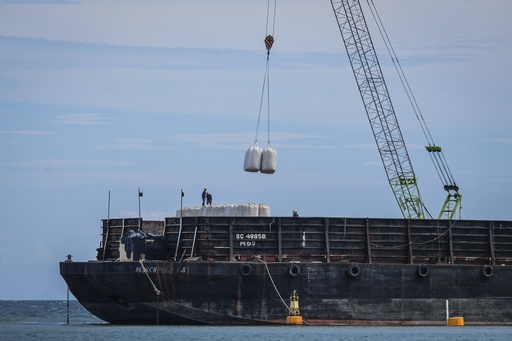
JAKARTA, Indonesia — Vast areas of untouched forest in Indonesia are being cleared to meet the soaring demand for biomass, which is increasingly seen as essential for many nations shifting toward cleaner energy sources.
Research into satellite imagery, corporate records, and Indonesian export statistics reveals that most of the biomass harvested from deforested areas for wood pellet production post-2021 has been exported to South Korea and Japan. These two countries have heavily invested in developing biomass production initiatives in Indonesia, contributing millions of dollars for support.
In addition to this international demand, Indonesia’s state-owned utility is planning a significant increase in biomass consumption for electricity generation. This situation raises significant concerns among experts and environmental advocates about the potential for intensified deforestation, particularly given the lack of robust domestic regulations. Biomass, which includes organic materials such as plants, timber, and waste, can be integrated into existing coal-fired power plants to produce energy.
“Industrial-scale biomass production is just beginning to emerge in Indonesia, posing a severe threat to the nation’s forests,” stated Timer Manurung, the director of the environmental organization Auriga Nusantara. As the global push for energy transitions gains momentum, the demand for biomass continues to rise. According to the International Energy Agency, bioenergy usage has surged at an annual rate of 3% between 2010 and 2022.
Experts, including those from the IEA, emphasize the necessity for sustainable biomass production practices, favoring the use of agricultural by-products and waste materials over converting forest land for bioenergy crops. Deforestation has numerous adverse effects, such as soil erosion, loss of biodiversity, threats to wildlife and human communities dependent on forests, and enhanced vulnerability to extreme weather events.
There is a significant portion of scientists and conservationists who dismiss biomass utilization altogether, arguing that combusting wood-based biomass can emit more carbon than coal and that logging habitats compromises forests’ capability to sequester carbon dioxide from the air. Detractors argue that co-firing biomass with coal simply delays the transition to truly renewable energy sources.
In Indonesia, the rise of biomass production is driving deforestation throughout the archipelago. Research from Auriga Nusantara indicates that over 9,740 hectares (approximately 24,070 acres) of forest have been cleared for biomass production since 2020. Permits have been granted covering more than 1.4 million hectares (around 3.46 million acres) for energy plantations, with more than a third of this area being previously undisturbed forest. Many of these zones are home to endangered species, including the Sumatran rhino, elephants, orangutans, and tigers, according to Manurung.
In the carbon-rich forests of Gorontalo in Sulawesi, the process of clearing, processing, and shipping aged trees for energy-dense wood pellets is becoming more efficient. Satellite tracking highlights that over 3,000 hectares (approximately 7,410 acres) of forest have been cleared in the concession areas of Banyan Tumbuh Lestari between 2021 and 2024, with an additional 2,850 hectares (about 7,040 acres) lost to the construction of logging roads.
After being cut down, trees are transformed into wood pellets at a facility near the concessions operated by Biomasa Jaya Abadi, which has emerged as the largest exporter of Indonesian wood pellets from 2021 to 2023. Data sourced from the Indonesian Ministry of Environment and Forestry indicates no recorded wood pellet exports before 2020.
Despite repeated attempts, Biomasa Jaya Abadi did not respond to inquiries. The company’s contact details for Banyan Tumbuh Lestari remain unavailable, and attempts to reach their major shareholders have gone unanswered. Furthermore, Indonesia’s ministries involved did not respond to inquiries regarding these matters.
Alloysius Joko Purwanto, an energy economist with the Economic Research Institute for ASEAN and East Asia, emphasized that nearly all wood pellets produced in Indonesia are exported to address international market needs. From 2021 to 2023, most of these pellets (61%) were sent to South Korea and 38% to Japan.
“The governments of Japan and South Korea appear keen to increase biomass imports from Indonesia to reduce their domestic carbon emissions,” noted Bhima Yudhistira, executive director of the Center of Economic and Law Studies in Indonesia. Both nations have previously contributed significant financial resources towards biomass development in Indonesia encompassing research initiatives, policy frameworks, and infrastructure support.
In conjunction with the promotion of biomass production, Indonesia’s domestic biomass use is also on the rise. The country’s state electricity company, Perusahaan Listrik Negara (PLN), has plans for a 10% biomass co-firing rate for 52 coal plants nationwide. PLN projects this initiative will require approximately 8 million tons of biomass annually, far exceeding the current production capacity of less than 1 million tons, as reported by Indonesian civil society group Trend Asia.
Achieving PLN’s objectives would necessitate a 66% expansion in forest plantation areas, which according to a report from Mighty Earth, could lead to further destruction of existing, carbon-rich forests. PLN’s spokesperson, Gregorius Adi Trianto, articulated that the company’s biomass strategy focuses on materials sourced from organic waste, including tree branches and rice waste, rather than directly from forests.
However, in light of unclear regulations and oversight within Indonesia’s expanding biomass sector, there are growing concerns among experts that deforestation rates could surge in the coming years. “The monitoring and regulation of biomass production in Indonesia are already lagging significantly,” Yudhistira remarked. “The situation reflects a troubling lack of diligence, and ultimately, forests are paying the price.”
